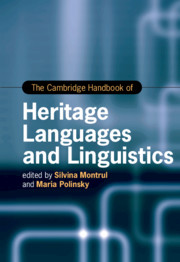Book contents
- The Cambridge Handbook of Heritage Languages and Linguistics
- Cambridge Handbooks In Language And Linguistics
- The Cambridge Handbook of Heritage Languages and Linguistics
- Copyright page
- Dedication
- Contents
- Figures and Tables
- Contributors
- Acknowledgments
- Introduction
- Part I Heritage Languages around the World
- Part II Research Approaches to Heritage Languages
- Part III Grammatical Aspects of Heritage Languages
- Part IV Heritage Language Education
- 29 Elementary School Heritage Language Educational Options and Outcomes
- 30 Community-Organized Heritage Language Programs
- 31 Curricular and Programmatic Language Development Opportunities for University-Level Heritage Language Learners
- 32 Instructed Heritage Language Acquisition
- 33 Issues and Practices in Community-Based Experiential Learning for Heritage Speakers in the United States
- 34 Developing Spanish Heritage Language Biliteracy
- 35 Heritage Language Assessment
- 36 Embracing Opportunity in Heritage Language Revitalization
- 37 Heritage Language Planning and Policy
- Index
- References
34 - Developing Spanish Heritage Language Biliteracy
from Part IV - Heritage Language Education
Published online by Cambridge University Press: 04 November 2021
- The Cambridge Handbook of Heritage Languages and Linguistics
- Cambridge Handbooks In Language And Linguistics
- The Cambridge Handbook of Heritage Languages and Linguistics
- Copyright page
- Dedication
- Contents
- Figures and Tables
- Contributors
- Acknowledgments
- Introduction
- Part I Heritage Languages around the World
- Part II Research Approaches to Heritage Languages
- Part III Grammatical Aspects of Heritage Languages
- Part IV Heritage Language Education
- 29 Elementary School Heritage Language Educational Options and Outcomes
- 30 Community-Organized Heritage Language Programs
- 31 Curricular and Programmatic Language Development Opportunities for University-Level Heritage Language Learners
- 32 Instructed Heritage Language Acquisition
- 33 Issues and Practices in Community-Based Experiential Learning for Heritage Speakers in the United States
- 34 Developing Spanish Heritage Language Biliteracy
- 35 Heritage Language Assessment
- 36 Embracing Opportunity in Heritage Language Revitalization
- 37 Heritage Language Planning and Policy
- Index
- References
Summary
This chapter presents perspectives and implications for the classroom to lay out a research agenda toward continued development of our understanding of the ways Spanish heritage learners develop biliteracy for academic and professional purposes. Multilingualism is an increasingly growing phenomenon in our globalized society and the learning and teaching of minority languages in schools require a more adequate approach that could address differences in use (professional, social, etc.) as well as differences in users of the language (ethnic or cultural). The changing landscape of Spanish biliteracy teaching and learning in educational institutions is examined and the concept of a holistic and functional approach to developing advanced literacy in institutional contexts is presented. The chapter considers how the experience of meaning-making is negotiating discourse differences in many social contexts, i.e., new literacies and multiliteracies are embodied in new social practices.
- Type
- Chapter
- Information
- The Cambridge Handbook of Heritage Languages and Linguistics , pp. 867 - 891Publisher: Cambridge University PressPrint publication year: 2021
References
- 2
- Cited by



